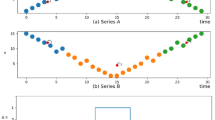Abstract
Specific network space, including virtual space and practical space, is a space for executing group behavior on specified regions via network. Due to the variability and unpredictability of time series in group behavior in special network space, the detection of normal and abnormal borders faces significant challenges. The parameters in traditional time series mode need to be predefined such as clustering method and anomaly detection methods science the results influentially depend on the selection of parameters. According to the characteristics of data, this paper proposes an efficient method called separation degree algorithm that can construct the self-adaptive interval based on the separation degree model to filter out anomaly data in virtual and practical spaces. The advantage allows us to automatically find the self-adaptive interval to improve the accuracy and applicability of anomaly detection based on the characteristics of the data instead of set parameters of traditional methods in network space. The extensive experimental result shows that the proposed method can effectively detect anomaly data from different spaces.






Similar content being viewed by others
References
Elías, A., Ochoa-Zezzatti, A., Padilla, A.: Anomalyanalysis for plastic card fraud detection a hybridized and multi-objective approach. Hybrid Artif. Intell. Syst. 29(3), 1–9 (2011)
Garces, H., Sbarbaro, D.: Anomalys detection in environmental monitoring databases. Eng. Appl. Artif. Intell. 24(2), 341–349 (2011)
Khalastchi, E., Kalech, M.: Online data-driven anomaly detection in autonomous robots. Knowl. Inf. Syst. 43(3), 657–688 (2015)
Arakawa, Y., Tagashira, S., Fukuda, A.: Relationship analysis between user contexts and input word with Twitter. Trans. Inf. Process. Soc. Jpn. 52(7), 2268–2276 (2011)
Tu, H.: An efficient clustering algorithm for microblogging hot topic detection. In: International Conference onComputer Science & Service System (CSSS), Nanjing, pp. 738–741 ( 2012)
Chen, K.Y., Luesukprasert, L., Chou, S.C.T.: Hot topic extraction based on timeline analysis and multidimensional sentence modeling. IEEE Trans. Knowl. Data Eng. 19(8), 1016–1025 (2007)
Dai X.Y., Chen Q.C., Wang X.L.: Online topic detection and tracking of financial news based on hierarchical clustering. In: Proceedings of the 9th International Conference on Machine Learning and Cybernetics, Qingdao, pp. 3341–3346 (2010)
Shaikh, S.A.: Top-k anomaly detection from uncertain data. Int. J. Autom. Comput. 11(2), 128–142 (2014)
Han, Z.M., Chen, N., Le, J.J.: An efficient and effective clustering algorithm for time series of hot topics. Chin. J. Comput. 35(11), 2337–2347 (2012)
Xu, R., Wunsch, D.: Survey of clustering algorithms. IEEE Trans. Neural Netw. 16(2), 645–678 (2005)
Alex, R., Alessandro, L.: Clustering by fast search and find of density peaks. Science 344(96191), 1492–1496 (2014)
Tsapanos, N., Tefas, A.: A distributed framework for trimmed kernel k-means clustering. Pattern Recogn. 48(8), 2685–2698 (2015)
Kaufman, L., Rousseeuw, P.J.: Finding Groups in Data: An Introduction to Cluster Analysis. Wiley, New York (2009)
Jain, A.K.: Data clustering: 50 years beyond K-means. Pattern Recognit. Lett. 31(2), 651–666 (2010)
Breunig M.M., Kriegel H.P., Ng R.: LOF: identifying density-based local anomalys.In: Proceedings of ACM SIGMOD Conference, Dalles, pp. 93–104 (2000)
Dudik, J.M.: A comparative analysis of DBSCAN, K-means, and quadratic variation algorithms for automatic identification of swallows from swallowing accelerometry signals. Comput. Biol. Med. 59(2), 10–18 (2015)
Ahn, Y.-Y.: Link communities reveal multiscale complexity in networks. Nature 466(7307), 761–764 (2010)
Acknowledgments
This work is supported by The Ocean Public Welfare Project of the Ministry of Science and Technology (No. 201105033) and The National Natural Science Foundation of China. (No. 40976108)
Author information
Authors and Affiliations
Corresponding author
Rights and permissions
About this article
Cite this article
Wang, L., Xu, L., Xue, Y. et al. Group behavior time series anomaly detection in specific network space based on separation degree. Cluster Comput 19, 1201–1210 (2016). https://doi.org/10.1007/s10586-016-0583-8
Received:
Accepted:
Published:
Issue Date:
DOI: https://doi.org/10.1007/s10586-016-0583-8




